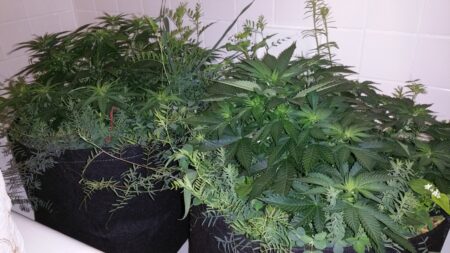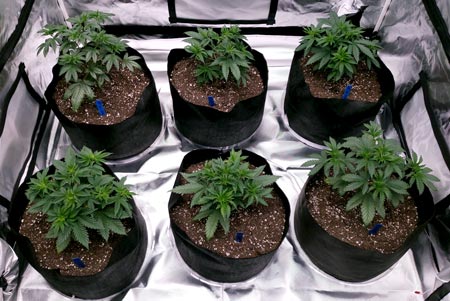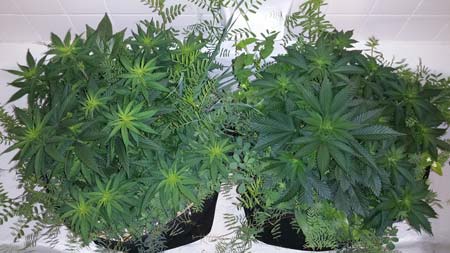by WeedyPests (with forward by Nebula Haze)
Have you heard of “no-till” organic cannabis growing? What does that mean and is it a good choice for growing cannabis? Is it better than simpler organic methods like growing in “just add water” super soil?
Today I’ll share a tutorial that was submitted to GrowWeedEasy.com by the grower WeedyPests. I have never grown with this method but many marijuana growers swear by it. I wanted to get this information out there and start getting feedback from more growers. What do you think about the “no-till” cannabis growing method from this no-till tutorial? Contact us and let us know!
If you guys haven’t already tried a no-till grow, I would highly recommend trying and documenting it. The main information I’m finding on organic growing on GrowWeedEasy.com is about super soil, which is an organic grow style, but uses a fundamentally different concept compared to no-till.
Let me try giving a basic rundown on the differences.
Super Soil gets discarded and replaced for the next grow
With Super Soil, you are providing many hot ingredients integrated into the bottom layer of your container to provide all of the nutrients needed for the entire grow, after which, the soil is discarded and replaced for the next grow.
With “Super Soil” you add a layer of “hot” nutrient-rich composted soil to the bottom of your pot. Cannabis roots dip into this reservoir of nutrients throughout the grow. After plants start growing, the only thing a grower adds is water. This is why it’s often called “Just add water” super soil. At the end of grow, the soil gets thrown away and is replaced to start the next grow.
You guys already know this having previous experience with super soil growing. In fact, super soil is more closer in concept to a traditional bottled nutes grow than no-till is.
No-till soil gets re-used and built up over time, just like soil in nature
No-till, on the other hand, tries to mimic nature as closely as possible. When following Coot’s Mix as a base for your no-till soil (which I recommend), you are adding no hot ingredients that tend to burn your plants.
This means that you fill your entire container up with the no-till soil, and this also means that the same soil is good from seedling to maturity.
With Coot’s Mix, you are indeed adding most, if not all, of the nutrients that you will need for the entire grow, just like with super soil, but unlike super soil, no-till (by its name) is meant to be reused, and actually gets better over time the more you use it.
Example of cannabis plants grown in a “No Till” soil setup with cover crops
Ingredients for Coot’s No-Till Soil Mix
Note: Credit for this recipe goes to Clackamas Coots.
This recipe makes 15 gallons (2 cubic feet) of soil. That is enough to fill about 3 x 5-gallon pots.
Base: This will make up your base. Essentially, you want 1/3 of each of these in the base mix.
- 5 gallons Compost
- 5 gallons Peat Moss
- 5 gallons Aeration material (such as pumice stone, rice hulls, or lava rock)
Additional Inputs:
- 1/2 cup Kelp Meal
- 1/2 cup Crustacean Meal (or bone meal)
Minerals
- 1 cup Basalt
- 1 cup Glacial Rock Dust
- 1 cup Gypsum
- 1 cup Oyster Shell Flour
Basic Steps of a No-Till Grow
1: Mix your soil according to Coot’s Mix using a high quality compost and/or earthworm castings. Alternatively, you can get fantastic premade soils from sources like Build-A-Soil and KiS Organics (or if you’re in Canada, Black Swallow Soil sells KiS soil). You’re going to need enough soil to fill a minimum of 15 gallon containers per plant, with 25-30 gallons per plant being recommended. Fabric pots or raised beds preferred.
2: Fill a red party cup with that soil mixture (no need to let it cook like with super soil, although it can’t hurt if you do), and cut a few holes on the bottom for drainage.
3: Add worms to your big container of no-till. This is vital to the continued life of your soil, as they will eat through decomposed material, including old plant roots (but not living ones). The worms will also produce earthworm castings, which are a fantastic source of nutrients for your plants. If you do not have worms, it’s not really a no-till grow. Be sure to water your soil to keep the worms alive even though there’re no plants in there yet.
4: Plant your seed/seedling (germination method is up to you) directly in the red party cup, digging about 1/4 in deep as you normally would with any medium. Be sure to sprinkle some myco powder inside the hole before you drop the seed or seedling in. Myco is a benefitial fungus that attaches itself to plant roots and boosts its growth substantially.
5: Transplant. Once your seedling has sprouted and you feel it’s a good time to transplant, go ahead and transplant as normal; nothing different here when compared to any other type of grow.
6: Add a mulch layer directly after transplanting. I personally like barley straw, as it’s cheap, feeds the worms, and is very lightweight. Some people also like to use a living mulch layer, like clovers for example. This is completely personal preference and there are pros and cons to both.
7: Use compost tea. When your plant seems to be getting hungry, make and feed a compost tea to stimulate the biology present in the soil. With no-till, you are feeding the soil, not the plants. If the compost tea doesn’t seem to be doing enough, you can topdress with additional nutrients and minerals that you have leftover from mixing your Coot’s Mix soil. To topdress, sprinkle your nutrients about 1/4 in thick along the surface of the soil, work it into the first 1 in of the soil, then water it in.
8: Rinse and repeat step 7 until harvest.
After harvest
1: Cut plant at the base. To harvest, cut down the main stem level to the soil, and be sure to agitate the soil as little as possible (this IS called no-till, after all).
2: (Optional) Soil test. Optionally get a soil test done on your soil to know exactly what nutrients you need to add and to correct your pH as neceasary (pH range is the same as regular soil growing). Alternatively, you can just add some nutrients and minerals to your soil by topdressing and watering, as there’s no risk of burning your plants due to the lack of hot ingredients. I like to do a soil test after every 3 grows in the same soil.
3: Start another plant. It is beneficial to constantly have plants growing. Either cannabis and/or cover crops. You do not have to wait at all from harvest to plant a new plant. Plant the new plant about a couple of inches away from the old main stem (eventually, the old plant’s roots will decompose enough that you can just twist and pull the old main stem out).
Where to learn more
For a fantastic community on the topic of no-till growing, check out /r/NoTillGrowery on Reddit.
The preferred way to contact the author of this cannabis no-till tutorial is via Reddit (username /u/WeedyPests).



